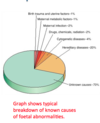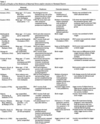SPR L2 Prenatal Development Flashcards
Learning Outcomes
- Describe the stages of prenatal development
- List different environmental factors that may adversely impact upon the development of the foetus
- Describe how environmental factors can interact with the stages of prenatal development to influence foetal outcome with reference to case studies
What are the three stages of prenatal development?
- Period of the Zygote - ovulation to implantation
- Embryonic Period - implatation to 8 weeks
- Foetal Period - 8 weeks to birth

Period of the Zygote
- How many succeed to implant?
- How many of the implants fail to develop?
- What are the reasons for this?
- Give an overview of Week 1
- GIve an overview of Week 2
- 1/2
- 1/2
- Genetic abnormalities, and they burrow into a site that is incapable of sustaining them
- Zygote undergoes Mitosis, Blastocyst Implantation
- Blastocyst is fully implanted, embryonic disk forms

Period of the Embryo
- What happens in the first month?
- What happens in the second month?
- Give an overview of the embryo at the end of this period
- Rapid Growth
Neural tube
Heart
Eyes, ears, nose, mouth
Limb buds
- Rudimentary skeleton
Limbs: forearm-upper arm-hands-fingers
Rapid brain development
Indifferent gonad
Face development: http://ow.ly/tsizl
- By end, embryo is approx. an inch long, weighs 7 grams, but all major organs have formed and it is recognisably human.

Period of the Foetus
Foetus begins to move, sense and behave- individuality emerges.
- Outline the 3rd month
- Outline 4-6th month
- Outline 7-9th month
- Nervous/muscular interconnect – perform manoeuvres
Digestive/excretory interconnect – swallow, digest, urinate
testosterone secretion in males– external genitalia form allowing detection of sex of baby by ultrasound
2. Mouth/lips/tongue /larynx movement become increasingly complex allowing foetus to practice sucking, munching, hiccupping, breathing, coughing, snorting.
Kicks strong enough to be felt, heartbeat easily heard with stethoscope at 4 months and without by 5 months.
Nails/skin thickens, eyebrows, eyelashes, scalp hair appear (5 months)
Sweat glands begin functioning (5 months)
Foetus is covered in vernix caseosa and lanugo.
Visual and auditory senses clearly functional at 6 months– evidence from preterm babies
Foetus reaches ‘age of viability’.
- Organ systems mature (pulmonary alveoli –problem for preterm babies).
Systems start showing better organisation and predictability regarding cycles.
Fat deposition for insulation.
Sleep increases in 9th month and movement is restricted by decreasing space.

When is the second scan carried out?
Why?
Second scan to diagnose illness.
This can also facilitate bonding.
When does the foetus reach the ‘age of viability’?
4-6 months
What is termed the ‘finishing phase’?
7-9 months
Name the three stages of Prenatal Development and when they occur
- Zygote (weeks 1-2)
- Embryo (weeks 3-8)
- Foetus (weeks 9-42)
When does the period of the zygote commence and end?
when the egg is fertilised and ends when the blastocyst is firmly embedded in the uterine wall.
What is the period of the embryo characterised by?
characterised by rapid development: all major organs and limbs are formed
What does the period of the foetus begin with?
What does this allow?
growth and integration of nervous/muscular system and the digestive/excretory system
allowing foetus to move reflexively, to swallow and excrete, and the differentiation of the sex organs
Summary
- What happens as the nervous system matures?
- What gives the baby insulation?
- When is the ‘age of viability’ reached?
- What happens in the ‘finishing period’?
- How is most time spent?
- the brain progressively begins to take control of all major functions including control of the heart and of movement. Reflexes can be seen to facilitate this process, kick-starting a process of continuous feedback that refines movement over time.
- The foetus develops lanugo (downy hair) and is covered in vernix caseosa (waxy white substance)
- around 5-6 months - lungs begin to mature and begin to be able to be capable of breathing air. Lungs are last thing to mature and limit our ability to reduce the age of viability.
- (last three months) increase in body fat, movement is restricted due to loss of space and the brain is fine tuning it’s regulation of functions and it’s interconnections
- Most time is spent asleep.
Outline the 3 risk groups to foetal development
- Genetic abnormalities (10-25%)
- Single environmental agents –teratogens (up to 10%)
- Remainder (majority) result of complex gene-environment interactions that could include:
- Teratogens
- Maternal Nutrition
- Maternal Stress
- Labour complications

What is the majority of risks to foetal development made up by?
Remainder (majority) result of complex gene-environment interactions that could include:
–Teratogens
–Maternal Nutrition
–Maternal Stress
–Labour complications









